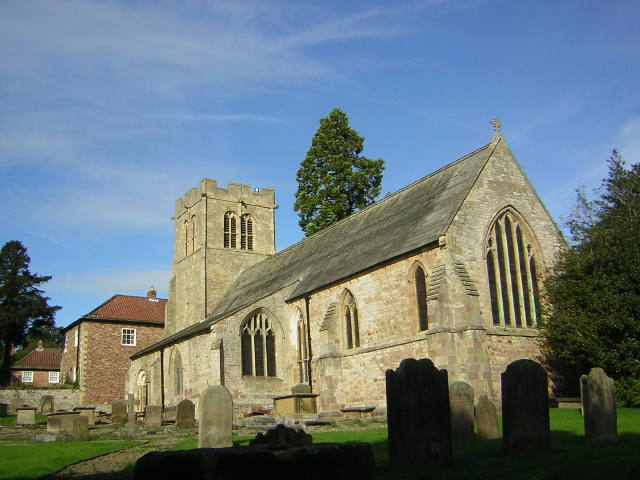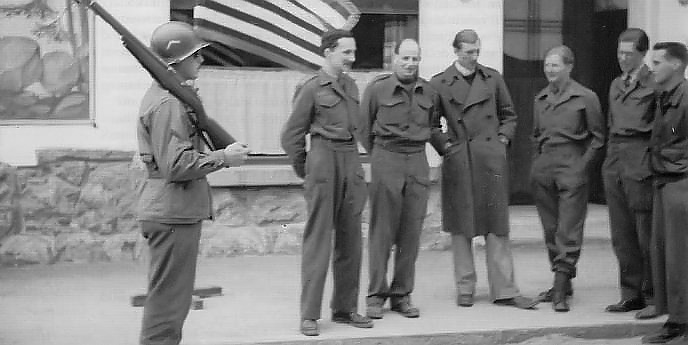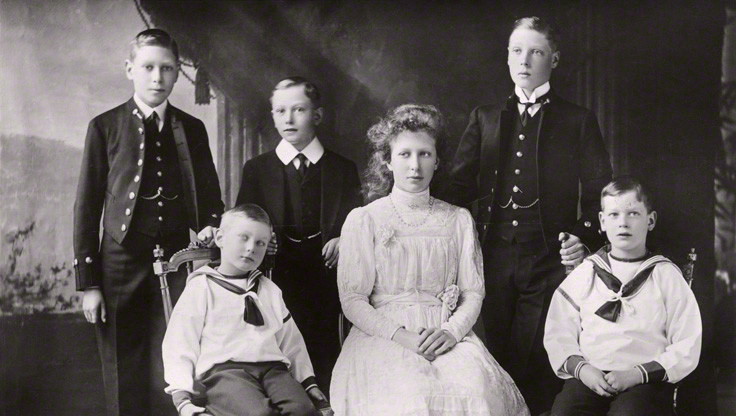|
Goldsborough, Harrogate
Goldsborough is a village and civil parish in the Harrogate district of North Yorkshire, England. It is situated near the River Nidd and east of Knaresborough. Goldsborough is recognised by the well-known stately home Goldsborough Hall and its other features including: Goldsborough Primary School, the Bay Horse Inn and the Goldsborough Cricket Grounds. The village was historically part of the West Riding of Yorkshire until 1974. History The village appears in the Domesday Book as Golburg or Goldeburgh, which means Golda's Burgh (with Burgh meaning a fortified place). It was in the possession of the de Goldesburgh, Hutton and Byerley families at that time. The village was the seat of the short-lived Wytham Baronetcy during the 1680s. A Viking hoard was discovered in Goldsborough Village in 1859 during construction outside the north wall of Goldsborough Church. Coins and artefacts dating from 700 to 1050 were found in a leaden chest including fragments of Viking brooches an ... [...More Info...] [...Related Items...] OR: [Wikipedia] [Google] [Baidu] |
2011 Census For England And Wales
A census of the population of the United Kingdom is taken every ten years. The 2011 census was held in all countries of the UK on 27 March 2011. It was the first UK census which could be completed online via the Internet. The Office for National Statistics (ONS) is responsible for the census in England and Wales, the General Register Office for Scotland (GROS) is responsible for the census in Scotland, and the Northern Ireland Statistics and Research Agency (NISRA) is responsible for the census in Northern Ireland. The Office for National Statistics is the executive office of the UK Statistics Authority, a non-ministerial department formed in 2008 and which reports directly to Parliament. ONS is the UK Government's single largest statistical producer of independent statistics on the UK's economy and society, used to assist the planning and allocation of resources, policy-making and decision-making. ONS designs, manages and runs the census in England and Wales. In its capacity as t ... [...More Info...] [...Related Items...] OR: [Wikipedia] [Google] [Baidu] |
Villages In North Yorkshire
A village is a clustered human settlement or community, larger than a hamlet but smaller than a town (although the word is often used to describe both hamlets and smaller towns), with a population typically ranging from a few hundred to a few thousand. Though villages are often located in rural areas, the term urban village is also applied to certain urban neighborhoods. Villages are normally permanent, with fixed dwellings; however, transient villages can occur. Further, the dwellings of a village are fairly close to one another, not scattered broadly over the landscape, as a dispersed settlement. In the past, villages were a usual form of community for societies that practice subsistence agriculture, and also for some non-agricultural societies. In Great Britain, a hamlet earned the right to be called a village when it built a church. [...More Info...] [...Related Items...] OR: [Wikipedia] [Google] [Baidu] |
Scheduled Monument
In the United Kingdom, a scheduled monument is a nationally important archaeological site or historic building, given protection against unauthorised change. The various pieces of legislation that legally protect heritage assets from damage and destruction are grouped under the term "designation." The protection provided to scheduled monuments is given under the Ancient Monuments and Archaeological Areas Act 1979, which is a different law from that used for listed buildings (which fall within the town and country planning system). A heritage asset is a part of the historic environment that is valued because of its historic, archaeological, architectural or artistic interest. Only some of these are judged to be important enough to have extra legal protection through designation. There are about 20,000 scheduled monuments in England representing about 37,000 heritage assets. Of the tens of thousands of scheduled monuments in the UK, most are inconspicuous archaeological sites, but ... [...More Info...] [...Related Items...] OR: [Wikipedia] [Google] [Baidu] |
George Henry Hubert Lascelles
George Henry Hubert Lascelles, 7th Earl of Harewood, (7 February 1923 – 11 July 2011), styled The Honourable George Lascelles before 1929 and Viscount Lascelles between 1929 and 1947, was a British classical music administrator and author. He served as director of the Royal Opera House (1951–53; 1969–72), chairman of the board of the English National Opera (ENO) (1986–95); managing director of the ENO (1972–85), managing director of the English National Opera North (1978–81), governor of the BBC (1985–87), and president of the British Board of Film Classification (1985–96). Harewood was the elder son of the 6th Earl of Harewood and Princess Mary, Princess Royal, the only daughter of King George V and Queen Mary. At his birth, he was 6th in the line of succession; at his death, he was 46th. Lord Harewood was the eldest grandchild of King George V and Queen Mary, nephew of both King Edward VIII and King George VI and first cousin of Queen Elizabeth II. He succee ... [...More Info...] [...Related Items...] OR: [Wikipedia] [Google] [Baidu] |
George Gilbert Scott
Sir George Gilbert Scott (13 July 1811 – 27 March 1878), known as Sir Gilbert Scott, was a prolific English Gothic Revival architect, chiefly associated with the design, building and renovation of churches and cathedrals, although he started his career as a leading designer of workhouses. Over 800 buildings were designed or altered by him. Scott was the architect of many iconic buildings, including the Midland Grand Hotel at St Pancras Station, the Albert Memorial, and the Foreign and Commonwealth Office, all in London, St Mary's Cathedral, Glasgow, the main building of the University of Glasgow, St Mary's Cathedral in Edinburgh and King's College Chapel, London. Life and career Born in Gawcott, Buckingham, Buckinghamshire, Scott was the son of the Reverend Thomas Scott (1780–1835) and grandson of the biblical commentator Thomas Scott. He studied architecture as a pupil of James Edmeston and, from 1832 to 1834, worked as an assistant to Henry Roberts. He also worked as ... [...More Info...] [...Related Items...] OR: [Wikipedia] [Google] [Baidu] |
Goldsborough - Geograph
Goldsborough may refer to: Places Australia * Goldsborough, Queensland, a locality in the Cairns Region * Goldsbrough Mort Woolstore, a heritage-listed building in Brisbane, Queensland * Goldsbrough Mort Building, Rockhampton, a heritage-listed building in Queensland United Kingdom *Goldsborough, Harrogate, North Yorkshire **Goldsborough Hall **Goldsborough railway station, a closed station *Goldsborough, Scarborough, North Yorkshire Other uses * USS ''Goldsborough'', a list of ships with the name *Battle of Goldsborough Bridge, American Civil War * ''Goldsborough'' (novel), a 1953 novel by Stefan Heym, and the fictional town in the novel People with the surname *Brice Goldsborough, aviator and father of Frank Goldsborough *Charles Goldsborough, Governor of Maryland *Frank Goldsborough, aviator and son of Brice Herbert Goldsborough * James O. Goldsborough, American journalist *Sir John Goldsborough (died 1693), sea captain *John Goldesburg (1568–1618), legal reporter *John ... [...More Info...] [...Related Items...] OR: [Wikipedia] [Google] [Baidu] |
Henry Lascelles, 6th Earl Of Harewood
Henry George Charles Lascelles, 6th Earl of Harewood (9 September 1882 – 24 May 1947) was a British soldier and peer. He was the husband of Mary, Princess Royal, and thus a son-in-law of George V and Queen Mary and a brother-in-law to Edward VIII and George VI. Early life and marriage Lascelles was the son of Henry Lascelles, 5th Earl of Harewood, and Lady Florence Bridgeman, daughter of Orlando Bridgeman, 3rd Earl of Bradford. He was born at the London home of his maternal grandfather, 43 Belgrave Square. Article by H.E. Wortham, revised by K.D. Reynolds. Lord Harewood married Princess Mary, only daughter of George V and Queen Mary, at Westminster Abbey, on 28 February 1922. His best man was Sir Victor Mackenzie, 3rd Baronet. After their marriage, Lord and Lady Harewood split their time between their homes; Chesterfield House in London, and Goldsborough Hall, part of the Harewood Estate and Harewood House itself, in Yorkshire, which became their family home in 1930, a ... [...More Info...] [...Related Items...] OR: [Wikipedia] [Google] [Baidu] |
Mary, Princess Royal And Countess Of Harewood
Mary, Princess Royal and Countess of Harewood (Victoria Alexandra Alice Mary; 25 April 1897 – 28 March 1965), was a member of the British royal family. She was the only daughter of King George V and Queen Mary, the sister of Kings Edward VIII and George VI, and aunt of Queen Elizabeth II. In the First World War, she performed charity work in support of servicemen and their families. She married Henry Lascelles, Viscount Lascelles (later the 6th Earl of Harewood), in 1922. Mary was given the title of Princess Royal in 1932. During the Second World War, she was Controller Commandant of the Auxiliary Territorial Service. The Princess Royal and the Earl of Harewood had two sons, George Lascelles, 7th Earl of Harewood, and The Honourable Gerald Lascelles. Early life and education Princess Mary was born on 25 April 1897 at York Cottage on the Sandringham Estate in Norfolk, during the reign of her great-grandmother Queen Victoria. She was the third child and only daughter of the Du ... [...More Info...] [...Related Items...] OR: [Wikipedia] [Google] [Baidu] |
Daniel Lascelles (1714–1784)
Daniel Lascelles (1714–1784) was an plantation owner, merchant and politician who sat in the British House of Commons from 1752 to 1780. Born in BarbadosJames C. Brandow, ''Genealogies of Barbados families'', 1983, Genealogical Publishing and baptised at St Michael's, 20 May 1714 he resided at Goldsborough Hall near Knaresborough Yorkshire which estate he purchased about 1756. The second son of Henry Lascelles (1690–1753) and his first wife, Mary Carter he represented the constituency of Northallerton (UK Parliament constituency), Northallerton from 3 April 1752, succeeding his father, to 1780 when he stood down in favour of his elder brother Edwin Lascelles, 1st and last Baron Harewood, Edwin (1713-1795) who later became 1st Baron Harewood. He was a partner in the firm of Lascelles and Maxwell, sugar factors, of Mark Lane, London; which, following the death of George Maxwell in 1763 became Lascelles Clarke and Daling. Daniel married Elizabeth Southwick from whom he was d ... [...More Info...] [...Related Items...] OR: [Wikipedia] [Google] [Baidu] |
Richard Hutton (judge)
Sir Richard Hutton (1560 – 26 February 1639) was a Yorkshire landowner, and judge. He defied Charles I over ship money. Life Hutton was born and brought up at Hutton Hall in Penrith, Cumberland, the son of Anthony Hutton. He went to Jesus College, Cambridge, to study divinity but aged 20 headed to London to pursue a career in law. He was called to the bar in 1586 and was made a serjeant-at-law in 1603 under Elizabeth I. At this time, Hutton bought the estate at Goldsborough, near Knaresborough, West Riding of Yorkshire from the Goldsborough family, whose original thatched moated manor house had been destroyed after a quarrel over succession. Sir Richard Hutton bought out the claimants to the estate and built the present Goldsborough Hall to the south east of the village on raised ground close to the church. Hutton was made Recorder of York in 1608, Doncaster in 1609 and Ripon in 1610. He held these offices until 1617 when he was knighted by King James I on a visit to Yo ... [...More Info...] [...Related Items...] OR: [Wikipedia] [Google] [Baidu] |
Listed Building
In the United Kingdom, a listed building or listed structure is one that has been placed on one of the four statutory lists maintained by Historic England in England, Historic Environment Scotland in Scotland, in Wales, and the Northern Ireland Environment Agency in Northern Ireland. The term has also been used in the Republic of Ireland, where buildings are protected under the Planning and Development Act 2000. The statutory term in Ireland is " protected structure". A listed building may not be demolished, extended, or altered without special permission from the local planning authority, which typically consults the relevant central government agency, particularly for significant alterations to the more notable listed buildings. In England and Wales, a national amenity society must be notified of any work to a listed building which involves any element of demolition. Exemption from secular listed building control is provided for some buildings in current use for worship, ... [...More Info...] [...Related Items...] OR: [Wikipedia] [Google] [Baidu] |






